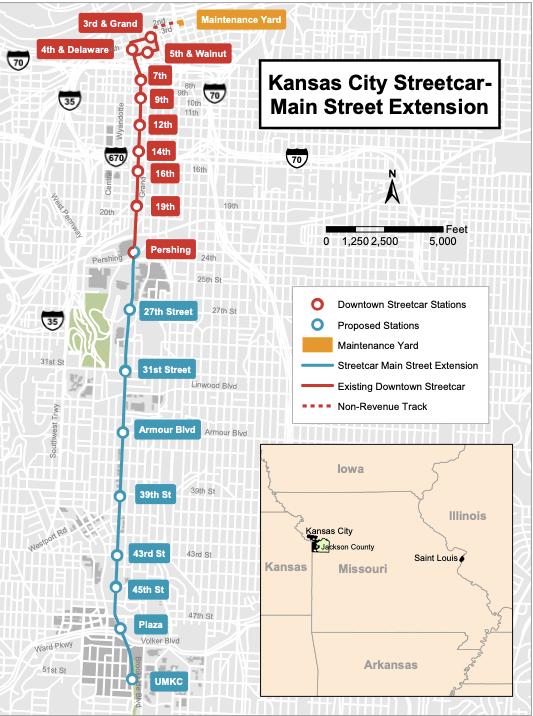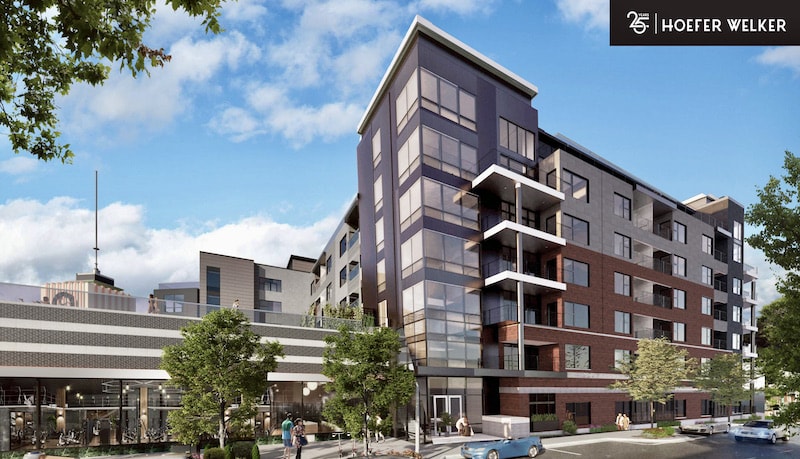Katz Redevelopment Plan Sparks Incentive Debate on Streetcar Route

Published June 11th, 2021 at 12:00 PM
By Kevin Collison
An apartment plan that would save the landmark Katz Drugstore has become the opening salvo in a City Hall debate over how–or whether–tax incentives should be available to assist developments planned along the new streetcar extension down Main.
Lux Living plans to seek a 25-year property tax abatement to help finance the cost of its apartment project at the corner of Main and Westport Road. It calls for restoring the historic drugstore and building a 192-unit apartment project behind it.
“We need the incentives to cover the cost of revitalizing the Katz building,” said Victor Alston, CEO of the the St. Louis development firm.
“If the city wants to preserve certain structures, the city needs to make it a priority or other projects will get built first and over time this building probably won’t be preserved.”
The incentive debate could affect the quality and amount of development along the streetcar route, expected to start operating by early 2025. There are already several projects valued at hundreds of millions of dollars in the works and more anticipated.
The Katz redevelopment, estimated by the developer as a $50- to $70 million investment, had sailed through the with support from Historic Kansas City, the city’s premier preservation group, and the neighborhoods.
But when it came up for a routine rezoning request at the City Council meeting April 15, Northland Councilman Kevin O’Neill fired what Mayor Quinton Lucas referred to as a “shot across the bow.”
“I consider our streetcar an incentive that we’re giving to the area,” O’Neill said. “I’m very concerned that they will come back and ask us for more incentives on top of the $300 million incentive we’re already giving.
“We have to draw a line on incentives at some point and I consider the streetcar a pretty big incentive.”

The proposed Katz apartment project is the latest development proposal sparked by the planned streetcar extension on Main Street between downtown and UMKC. (Drone photography courtesy Chris Stritzel)
Councilman Eric Bunch, who’s district includes Midtown, agreed with O’Neill’s “assessment” at the meeting.
“I think this is a great opportunity to save the Katz building,” he said. “I too have concerns about what the incentive package will look like.
“There will be extra costs associated, but you can guarantee I’ll be pushing back on the incentive request.”
While the rezoning request was approved unanimously, Lucas observed “I think we’ll keep our powder dry for a battle that may come later on everything else.”
The Katz tax incentive request is expected to be introduced at the Council Neighborhood, Planning and Development Committee next week and Historic KC is taking the unusual step of rallying its members to support the request.
“We believe incentives may be necessary to preserve this important and iconic historic structure,” the preservation group told members an a recent email.
“We have taken this position because of the importance of this building to the community and the fact that the preservation of important historic structures has often depended upon tax incentives that balance the cost of restoration.”

Major residential developments are in the works for the future streetcar stops at Armour, 39th Street and 45th Street. (Map from FTA)
O’Neill’s claim the streetcar extension on Main is a “city incentive” is misleading however, according to how the project is being funded.
The extension actually will cost about $350 million, half from the federal government and the remainder paid for by a transportation development district (TDD) which levies a special assessment and sales tax on properties and businesses in the streetcar corridor.
While the city does allocate about $2 million annually to support the streetcar, that money comes from a special mass transit sales tax and not the city general fund.
“The vast majority of dollars going to the streetcar come from either federal grants and other half comes from basically the individuals within the TDD voting to tax themselves,” said Councilwoman Katheryn Shields, who also represents the area.
And when it comes to future development, the streetcar TDD does not count property tax abatements granted developers but instead assesses the final project at full value.
“While the streetcar is a spur to development along the line, it doesn’t pay for the development,” said Doug Stone, general counsel to the Main Street Rail TDD.
“In fact, the development will help pay for the streetcar.”
Shields and Historic KC are focused on preserving historic buildings along the streetcar extension, which will run on Main from the terminus of the current downtown route at Union Station all the way to UMKC.
“We’re not going to save historic buildings along Main Street if we’re not willing to consider tax abatements for them,” Shields said.

The design of the apartment project planned for behind Katz has been tweaked to add a brick exterior to the lower levels. (Rendering from Hoefer Welker)
Lux Living wants a 10-year, 75 percent abatement and a 15-year, 37.5 percent abatement, a formula known as Lucas policy because the mayor had it successfully adopted by the Council a few years ago.
The redevelopment plan calls for renovating the Katz Drugstore and repurposing it to provide amenities, including a rooftop pool, for the six-story apartment building planned for the parking lot behind it.
The drug store opened in 1934 and was the first major building designed by famed Kansas City architect Clarence Kivett, who used the Art Deco style for the landmark clock tower and Art Moderne for the remainder of the building.
It was included on the 2019 Places in Peril list by the Missouri Alliance for Historic Preservation and this year’st by Historic KC.
In a follow-up interview, Bunch said he supports a property tax abatement for the plan, but significantly less than that being sought by the developer.
“I’m not opposed to all incentives on that project, but I do think the streetcar creates an increased opportunity for anybody developing on Main and that should be considered,” he said.
Bunch supports a 10-year, 75 percent tax abatement, citing a report by S.B. Friedman, a consultant which evaluated the developer’s incentive request for the city.
In its report, Friedman said that 10-year option, or a 15-year abatement at 75 percent for 10 years, and 37.5 percent for five years, were “viable alternatives” to assist the project.
“I know it (25 years) is a non-starter with many of us,” Bunch said.
O’Neill said he remains opposed to any additional incentives for the development.

The apartment building planned by Lux Living would replace the parking lot behind the Katz Drugstore.
The Katz property is now owned by a church and as a non-profit, does not generate any property taxes for the city or taxing jurisdictions including the school district.
A 25-year abatement as requested by Lux Living would allow the developer to keep $5.4 million in future property tax revenues to help finance the plan and yield about $5.5 million in new taxes for taxing jurisdictions, according to the Friedman analysis.
The 10-year abatement favored by Bunch would allow the developer to keep $3 million in future revenues and generate $7.9 million for schools, libraries and other taxing jurisdictions.
Bunch dismissed the fact almost all the money for the streetcar project is coming from non-city sources.
“It doesn’t matter where the money comes from, having that investment raises the demand,” he said.
“It will raise property values and more people will want to live along the route…We need as much housing as we can get and the higher rents it will fetch means we should not be incentivizing at a higher level.”

The northeast corner of 31st and Main where the 115 year-old Jeserich building is located has been acquired along the streetcar extension route. Preservationists believe incentives are vital to retain historic structures along the route.
Friedman reported that it’s market research had found apartments within a quarter-mile of the streetcar route rented on average 15 percent more than other locations.
The rents planned for the Katz project range from $1,150 for a 522 square-foot studio to $1,700 for an 833 square-foot two-bedroom unit, according to the Friedman report.
Bunch also suggested there should be opportunities for the developer to lease part of the ground floor of the old Katz building for retail space as demand grows along the streetcar route, a suggestion included in the Friedman report.
“They’re say it can’t be rented as retail and its all amenity space, I say that’s ridiculous,” he said.
Alton of Lux Living agrees the streetcar is a good incentive for developers, but insisted that in the case of preserving and reusing a historic building like the Katz Drugstore, more help is needed.
“The fundamental reason (for incentives) is preserving that building,” he said. “It costs money to buy it, retrofit it and get it up to historic standards and then finishing it out.”
The developer said it could be possible to build new projects along the streetcar route without incentives depending on land costs.
Those costs however, have been rising as owners speculate their property will be worth more–because of the streetcar.


